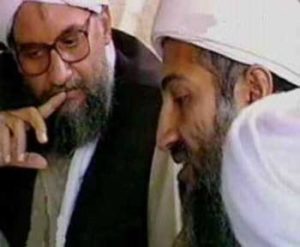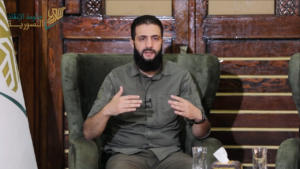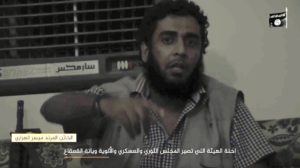Last month, a jihadi Telegram user called “And Rouse the Believers” leaked a series of documents related to the Islamic State’s internal ideological rift. As discussed in a previous post, this dispute revolves around the doctrine of excommunication (takfir), and specifically whether those hesitating or refusing to excommunicate unbelievers are themselves to be excommunicated. Heading up the more moderate side in this debate was Turki al-Bin‘ali, the emir of the Islamic State’s Office of Research and Studies, until his death in an airstrike in May 2017. The more extremist side was represented by the Delegated Committee, the Islamic State’s executive council, until Abu Bakr al-Baghdadi reconstituted it late last year and instituted a theological compromise of sorts.
“And Rouse the Believers,” whose name comes from Qur’an 4:84, is something of an anomaly: he is even more extreme than the extremists in this contest, believing that the Islamic State has lost its way. But that is beside the point. The documents he has unearthed shed considerable light on the origins of a struggle that continues to plague the ailing caliphate.
The Methodological Committee
One document is an internal memo on the activities of the so-called Methodological Committee (al-Lajna al-Manhajiyya), a body that was responsible for investigating the beliefs of the Islamic State’s scholars. It has also been referred to as the Office for Methodological Inquiry (Maktab al-Tadqiq al-Manhaji). As was seen before, the committee led an inquisition into senior Islamic State scholar Abu ‘Abd al-Rahman al-Shami al-Zarqawi, accusing him of holding too moderate a position on takfir.
According to the memo, the committee was formed in February 2016 as the result of a meeting between three Islamic State senior officials, Abu Muhammad al-Furqan, Abu Sulayman al-Shami, and a certain Abu Khabbab al-Masri. Al-Furqan, an Iraqi who headed the Islamic State’s Media Department, was killed in an airstrike in September 2016. Al-Shami, a Syrian-American known for his editorial work on the group’s English-language magazines, was killed by the same means in January 2017. The purpose of the committee was to take the measure of the numerous scholars, or “sharia officials” (shar‘iyyin), who had flocked to the the Islamic State, and to determine if any were guilty of ideological “transgressions.” The committee met with the scholars individually, asking them about their backgrounds, their journeys to the caliphate, and their views on takfir.
The committee was initially concerned, the memo explains, with the alleged “extremism” of some of the scholars, but it soon came to the conclusion that the greater problem was “Murji’ism,” a theological term denoting, in this context, undue leniency in takfir. The end of the memo comprises a chart with brief notes on the results of meetings with 29 scholars, including al-Bin‘ali, who is described as vehemently opposed to the work of the committee.
Called to repent
The entry on al-Bin‘ali also refers to his involvement in the case of Abu al-Mundhir al-Harbi, a Saudi scholar with the Office of Research and Studies who was accused of being soft on the issue of man-made law. Al-Harbi, who was affiliated with al-Qaida in Pakistan and Afghanistan from 2010 onward, arrived in Syria in 2014. Like al-Bin‘ali, he had an association with the jihadi ideologue Abu Muhammad al-Maqdisi, who wrote the introduction to his 2009 book defending al-Qaida’s terrorism. Sometime in 2015, he came under fire for his written answers to a series of questions put to the Islamic State by a group of prisoners in Baghdad. The answers were never published.
One of the questions was whether it was permissible to appeal to courts administering man-made law in order to recover something, such as property, that was wrongfully seized. In other words, is it allowed to take advantage of the court systems of unbelievers? Al-Harbi’s answer was yes, and al-Bin‘ali, among others, signed off on the response. But when the collected answers were brought to the Delegated Committee for review, some of its members balked. Seeking the judgment of other than God, as jihadis are keen to point out, is tantamount to ascribing partners to God, i.e., polytheism. Yet in the view of men such as al-Harbi and al-Bin‘ali, there are exceptions to such rules, and this was one of them.
“And Rouse the Believers” leaked two documents related to this episode. The first is a four-page brief on the Methodological Committee’s meeting with al-Harbi, written by Abu Sulayman al-Shami. It accuses al-Harbi of “permitting polytheism” and recommends that he be made to repent. The second document is a letter from al-Bin‘ali to the Office of the Caliph and the Delegated Committee, complaining that he too has been called to repent for “permitting polytheism.” Al-Bin‘ali was furious.
In his letter, dated November 2015, he explains that the accusation against him was brought by Abu Muhammad al-Furqan, who, he laments, refuses to see shades of grey in the issue of appealing to infidel courts. Though regretting some of the ambiguous language in al-Harbi’s response, he is firm in his view that the issue is not black and white. Even al-Furqan, he says, believes it permissible to pay ransoms to the Iraqi judiciary.
The letter also reveals that al-Furqan was serving as the “adviser” (mushrif) of the Office of Research and Studies, a role that al-Bin‘ali did not think him qualified for. Portraying him as deeply suspicious of the scholars, al-Bin‘ali advises that men with greater knowledge assist him in advising the office. Al-Furqan, he says, is reliant for his views on Abu Sulayman al-Shami, who is described as not very learned in religion. Al-Bin‘ali underscores his “severe displeasure” with the charge brought against him and “the extent of the divide between the Office of Research and Studies” and al-Furqan.
But if al-Bin‘ali saw al-Furqan and al-Shami as anti-intellectual extremists, he would soon be looking back at them as relative moderates.
Letter to Baghdadi
In late January 2017, about two weeks after the death of al-Shami, al-Bin‘ali wrote a letter to Baghdadi warning him against including the “extremists” in the power structure of the Islamic State. For months he had been hearing, he said, of a new policy intended to appease them by giving them a share of the top posts. But this “theory of balance” would needlessly embolden them. The fact of the matter, he went on, is that “the extremists’ numbers, even if they are great, are not greater than those who follow the truth.” Their power should therefore be curtailed, not enhanced.
This was a time, however, when the “extremists” were on the rise in the organization and the likes of al-Bin‘ali were losing out. In a lecture delivered in Raqqa back in late 2014 or early 2015, al-Bin‘ali had confidently stated, “What we proclaim is the creed of the Islamic State, and it is the creed of the Commander of the Believers … The methodology of the [Islamic] State, and the creed of the [Islamic] State, are issued by the Department of Research and Fatwas … this is by the seal of the Commander of the Believers [i.e., Baghdadi].” But soon the “department” was reduced to an “office” and the word “fatwas” was replaced with “studies,” symbolizing the decline in the influence of al-Bin‘ali and his outfit. The Methodological Committee was created soon afterward, and during the next year the Delegated Committee would release its explosive statement on takfir, prompting a strong reaction from the scholars.
One of the most senior scholars to object was a Saudi named Abu Bakr al-Qahtani, himself a member of the Delegated Committee at one point. “And Rouse the Believers” leaked part of a document, dated July 2017, advising that he repent of his all-too-tolerant position on takfir. This was about a month before he died in an airstrike. Like al-Bin‘ali, who met the same fate two months earlier, al-Qahtani was posthumously vindicated by the new statement on theology issued in September 2017. This statement—the “compromise” referred to above—was released in six installments. The most significant point that it makes is that takfir is “not part of the foundation of the religion” but rather “one of the requirements of the religion.” This was precisely al-Qahtani’s view. The internal memo on the Methodological Committee had complained that he relegated takfir to a subordinate status, as “one of the necessities of the foundation of the religion.”
A house divided
Al-Bin‘ali and al-Qahtani may have won the argument over takfir, but the new statement endorsing their views has been no salve to the ideological dispute. The Islamic State, and particularly its online support community, are more divided today than ever before. The ideological battlefield can be outlined as follows.
On one side stand the al-Wafa’ Media Foundation and the al-Turath al-‘Ilmi Foundation, two online media groups closely aligned with the Office of Research and Studies, or whatever is left of it. (The office is rumored to be headed today by a Jordanian named Abu Ya‘qub al-Maqdisi, but it is not clear that it is functional.) Al-Wafa’, which was created in April 2014, produces mostly unofficial written materials in support of the Islamic State, though occasionally it breaches the official-unofficial line. For instance, it recently published several pieces by Ahlam al-Nasr, the “poetess of the Islamic State” (see here, here, and here). Al-Turath, which was founded in October 2017, is primarily concerned with publishing the “heritage” (turath), written and otherwise, of the Islamic State’s scholars who were or still are with the Office of Research and Studies. Its releases include a six-volume collection of books and fatwas that runs to nearly 3,000 pages. According to al-Turath, this was assembled by al-Bin‘ali in August 2016, but the Delegated Committee and the Media Department obstructed its publication. Related to al-Wafa’ and al-Turath is a discussion group called “The Group for Constructive Criticism among the People of Islam,” a Telegram chatroom where like-minded Islamic State supporters congregate.
On the other side are a number of high-profile, pseudonymous activists and writers such as “Tarjuman al-Asawarti,” “Yemeni and Proud of My Islam,” and “Uncovering the Jews of Jihad and the Suspect Ones.” All of these are allied with the Islamic State’s Media Department, which the supporters of al-Wafa’ and al-Turath contend is a den of extremists. The Media Department, which is still very much active, is responsible for producing the Islamic State’s weekly Arabic newsletter, al-Naba’, which al-Wafa’ and al-Turath never promote or link to. Al-Asawarti and his allies often refer to the followers of al-Wafa’ and al-Turath as “the suspect ones” (al-mashbuhin), calling into question their support for the caliphate. The “suspect ones” consider their accusers “extremists.”
The two sides, the “suspect ones” and the “extremists,” frequently trade insults and refutations online. Back in February, Tarjuman al-Asawarti published a lengthy report about al-Wafa’, claiming that it is working against the interests of the caliphate, even that it is a spy cell. A prominent contributor to al-Wafa’ shot back with two rebuttals (see here and here). One of the biggest complaints against the “suspect ones” is that they are publishing official Islamic State products without the consent of the group’s leaders. Other complaints, such as that they work for the Rand Corporation, are not to be taken seriously.
It is hard to know which side has the numerical advantage online. Telegram has cracked down hard on the accounts of both sides, making it difficult to observe trends clearly. But the activity of the “extremists” seems to be the greater. Within the Islamic State itself, the dispute is less visible, but rumors abound that it remains intense. Al-Turath often leaks information about the scheming of the “extremists” and the periodic arrests of certain scholars.
A candle in the dark
In March of this year, al-Wafa’ published an essay by one of its senior writers calling on both sides to bury the hatchet and unify ranks. It does not seem to have had any effect. Yet there may be potential for reconciliation of another sort—with the more hard-line supporters of al-Qaida
Last month, one of the more prominent al-Qaida supporters on Telegram, “the Son of al-Qaida,” noted his “surprise” at the emergence of a “more open and balanced tendency” in the Islamic State, one following the teachings of al-Bin‘ali and less inclined to dismiss al-Qaida as heretics. Those belonging to this tendency, he says, are standing up to the “extremism” of the Islamic State. He further claims, perhaps too optimistically, that they are gaining ground, both “in the online space and on the ground.” From his point of view, this a welcome development, one that his pro-al-Qaida colleagues ought to embrace and encourage. “Don’t curse the darkness,” he tells them.“Rather, light a candle.” There is hope yet, he suggests, for this faction of the Islamic State.
The possibility of an al-Qaida-Islamic State merger has been oversold by some analysts, but another kind of jihadi reconciliation is conceivable. With the al-Qaida support network riven by its own factions of “moderates” and “extremists,” one can imagine a scenario where the “moderates” of the Islamic State and the “extremists” of al-Qaida eventually link up. This is probably a ways off, and may well require the dissolution of both jihadi organizations as a precondition. But the ideological common ground is there should a light be shone on it.




